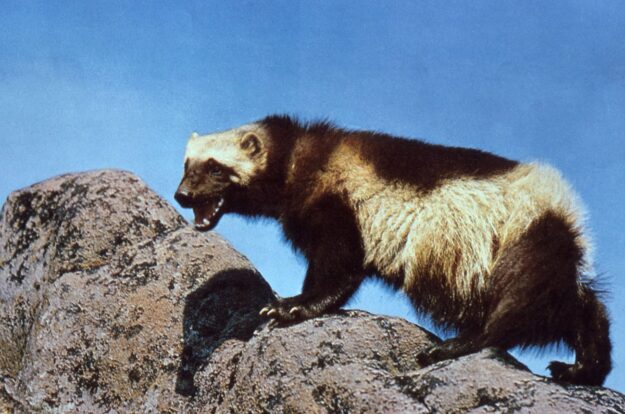Widgetized Section
Go to Admin » Appearance » Widgets » and move Gabfire Widget: Social into that MastheadOverlay zone
Colorado lawmakers passed bipartisan mountain wolverine reintroduction bill

A bill is sitting on the desk of Colorado Gov. Jared Polis that would begin a process of reintroduction of the wolverine, the largest member of the weasel family and a native Colorado species, back into the state.
Colorado legislators passed SB 24-171 with broad bipartisan support this session. It was co-sponsored by Rep. Barbara McLachlan (D-Durango), as well as Sens. Perry Will (R-New Castle), Dylan Roberts (D-Frisco), and Rep. Tisha Mauro (D-Pueblo).
Today wolverines live in isolated arctic, boreal and alpine regions of the Northern Hemisphere – Canada, Alaska, Siberia, Russia, the Baltic and Scandinavian states, as well as northeast China and Mongolia. It looks like a small, squat bear and is known for its strength, cunning, ferocity, and ability to face down larger predators twice its size. Its thick, oily fur is highly resistant to frost, which makes wolverine pelts highly valued by Northern Hemisphere hunters. That has led to a population decline around the world.
Currently, fewer than 400 wolverines live in the United States. Prior to being hunted, trapped and poisoned to extirpation in Colorado in the late 1800s and early 1900s, the wolverine has been found in northern-tier states bordering Canada and as far south as Colorado.
“There once was a viable population of wolverines in the state, however the last confirmed record was from 1919,” says Colorado Parks & Wildlife spokesperson Joey Livingston. “It is believed that wolverines were extirpated around this time due to unregulated trapping and poisoning. Twelve survey efforts from 1979-1996 yielded no confirmed sightings. Colorado’s high elevation and rugged terrain were and are good wolverine habitat, but because the species naturally exists in extremely low numbers wherever it is found, the species was never numerous here.”
Colorado’s last wolverine lived here between 2009 and 2012 after traveling 585 miles over a few months from the northwest corner of Wyoming to the mountains west of Breckenridge, crossing two interstates, several mountain ranges, and Wyoming’s vast and arid Red Desert. This wolverine eventually migrated out of the state.”
Wolverines are solitary scavengers and hunters of small to medium-sized prey but have been known to occasionally take down deer, elk, and moose – particularly if sick or injured, or trapped in deep snow. Wolverines have powerful jaws and sharp claws they can use to devastating effect on prey animals or larger predators like bears, cougars, or grey wolves. They have been known to follow the tracks of larger predators, in hopes of eating the remains of animals killed by the larger predators.
McLachlan recently told a KOA radio audience that the motivation of the bill was to restore a viable population of wolverines in the Colorado high country. She said the bill provides the Colorado Parks & Wildlife Department with time to prepare for transplanted wolverines – perhaps from Canadian or Alaskan population (yet to be determined).
McLachlan said legislators, the governor and CPW itself are highly aware of how wolf reintroduction has been playing out in the agriculture community.
“We want to be very cautious in how this is done. I actually talked to some of my Durango ranchers who oppose wolverine reintroduction,” she said.
Why? Not because they worry that wolverines in the high country will prey on their livestock, but just because of the bad taste from wolf reintroduction. There is very little overlap between wolverine high-altitude territory and land where sheep and cattle graze.
According to Sen. Roberts, reached via text by the Colorado Times Recorder, the only known wolverine predation on Colorado was in 1980, when two sheep got lost from their flock and wandered up higher than shepherds had expected.
The bill requires that a reintroduced wolverine population be regarded as non-essential and experimental. The bill also says rules for compensation must be worked out for livestock killed by reintroduced wolverines.
McLachlan said no one was tempted to take the issue before voters, like the wolf reintroduction. By running through the legislature, there won’t be resentment on the part of ranchers, against Front Range environmentalists who don’t have to deal with the consequences of wolverine reintroduction. She also explained that the reintroduction process is lengthy, predicting at least three years before any animals would actually arrive in Colorado’s high country.
“CPW anticipates the reintroduction of wolverines would look similar to many other wildlife reintroductions carried out by CPW in the past (e.g., Canada lynx, river otter, moose, Black-footed ferret, others),” says Livingston. “Wolverine reintroduction has been discussed publicly for a long time in Colorado. Once initiated, the process will likely involve CPW gathering input from wildlife experts, reaching out to other states and provinces that could be potential sources, and keeping the public informed. A draft restoration plan was recently presented to the Parks and Wildlife Commission and will be finalized soon.”
“Wolverines are at risk of becoming endangered,” says Roberts, “and therefore, Colorado can play a role in preventing that designation, which could cause a lot more problems.”
Editor’s note: This story first appeared on the Colorado Times Recorder website.
Brodie Farquhar
Latest posts by Brodie Farquhar (see all)
- Opinion: Worth asking this July 4 weekend — will Trump conspire with GOP to cancel 2026 elections? - July 5, 2025
- Opinion: Let’s ’86’ the idea that hospitality term is a threat to assassinate someone - May 21, 2025
- Colorado links to Project 2025 abound, including Beaver Creek’s ‘freedom fest’ - November 5, 2024


